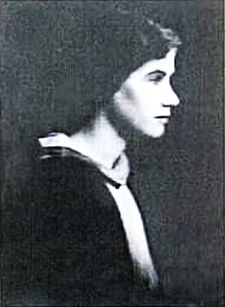- Mary Gordon Calder
-
Mary Gordon Calder 
Mary Gordon Calder (circa 1929)Born c. 1906
Uddingston, ScotlandDied 1992 (aged 85–86)
Milngavie, ScotlandFields Paleobotany Doctoral advisor James Drummond
John WaltonAuthor abbreviation (botany) Calder Mary Gordon Calder (c. 1906–1992) was a Scottish paleobotanist. She is known for her work on Carboniferous fossil plants and Jurassic conifers.
Contents
Early years
Mary Gordon Calder was born in Uddingston, South Lanarkshire, Scotland to William Calder, a general manager of a warehouse. She contracted poliomyelitis as a child, requiring her to wear leg braces for the rest of her life.[1]
Life in Glasgow
Calder was interested in biological and chemical sciences, and at the age of 18, she entered the University of Glasgow to study botany. Her mother, a reputedly passionate amateur botanist, may have influenced her in this. She graduated in 1929 with honours and went on to work as a researcher in Glasgow. She first pursued her doctorate under James Montague Frank Drummond (not to be confused with the Australian botanist James Drummond), the then Regius Professor of Botany in the University of Glasgow.[1][2]
Her first paper was about tomatoes, a choice influenced by Drummond. However, it was never published, as Drummond was replaced as Regius Professor of Botany by John Walton in 1930.[2] Walton, an internationally recognized paleobotanist,[3] encouraged her in the study of plant fossils, a field Calder herself was very interested in. She abandoned her earlier paper on tomatoes and began work on a catalogue of the large collection of coal ball slides by the Scottish paleobotanist Robert Kidston. She published her first paper on Carboniferous scale trees (class Isoetopsida of division Lycopodiophyta) and received her PhD in 1933.[1]
Calder continued working at Glasgow and published several more papers on Carboniferous lycopods in 1933 to 1934. In 1935, she published a paper on petrified pteridosperms (seed ferns) using the revolutionary cellulose peel techniques developed by Walton in 1928. Unlike previous techniques which utilized thin sections of rock, the cellulose peel method allowed more details of the fossils to be preserved. She also became a lecturer at Glasgow in 1936, allowing her to pursue her own studies.[1]
In 1938, Calder worked on the seed plants Calymmatotheca kidstonii and Samaropsis scotica, both from the Tournaisian age (345.3 to 359.2 million years ago) of the Lower Carboniferous (Mississippian).[4][5] The two species were later studied further by Albert G. Long in 1959 and emended to Genomosperma kidstonii and Lyrasperma scotica. They became significant as one of the oldest known seed plants discovered with fossilized ovules, providing an important early glimpse into the evolution of reproduction in seed plants.[1]
Life in London and Machester
In 1940, Calder moved to London and worked as a lecturer in Westfield College (then only admitting women). After the war, she was appointed as the senior lecturer in paleobotany at the University of Manchester in 1950. She succeeded the British botanist William Henry Lang in the post. She published one more paper in 1953 on Araucaria mirabilis, Araucarites sanctaecrucis, and Pararaucaria patagonica; all of which are araucarian conifers from the Middle Jurassic petrified forests of Argentina. She did not publish any more papers during her tenure, possibly because of a difficulty in adjusting to life in Manchester.[1]
She left the University of Manchester in 1964. She officially retired in 1966 to the town of Milngavie in Scotland near Glasgow, where she died in 1992.[1]
Legacy
Calder left a substantial bequest to the University of Glasgow. The funds were used to improve the University's facilities of the Institute of Biomedical and Life Sciences. A plaque in her memory can be found in the Joseph Black Building.[1]
See also
References
- ^ a b c d e f g h H.E. Fraser and C.J. Cleal (2007). The contribution of British women to Carboniferous palaeobotany during the first half of the 20th century. "The role of women in the history of geology". Geological Society, London, Special Publications (The Geological Society of London) 281: 51–82. doi:10.1144/SP281.4. ISBN 9781862392274. http://books.google.com.ph/books?id=9Pc-KlQ3I54C&lpg=PP1&pg=PA69#v=onepage&q&f=false.
- ^ a b "The University of Glasgow Story: Botany (Regius Chair)". The University of Glasgow. http://www.universitystory.gla.ac.uk/chair-and-lectureship/?id=730. Retrieved November 18, 2011.
- ^ "John Walton (1895-1971)". The University of Glasgow. http://www.universitystory.gla.ac.uk/biography/?id=WH1430&type=P. Retrieved November 18, 2011.
- ^ "Genomosperma". Paleobiology Database. http://paleodb.org/cgi-bin/bridge.pl?a=checkTaxonInfo&taxon_name=Genomosperma&is_real_user=1. Retrieved November 18, 2011.
- ^ "Lyrasperma". Paleobiology Database. http://paleodb.org/cgi-bin/bridge.pl?a=checkTaxonInfo&taxon_no=157159&is_real_user=1. Retrieved November 18, 2011.
Categories:- Scottish scholars and academics
- Female academics
- Scottish paleontologists
- Paleobotanists
- 1900s births
- 1992 deaths
- People from Uddingston
- Alumni of the University of Glasgow
Wikimedia Foundation. 2010.
